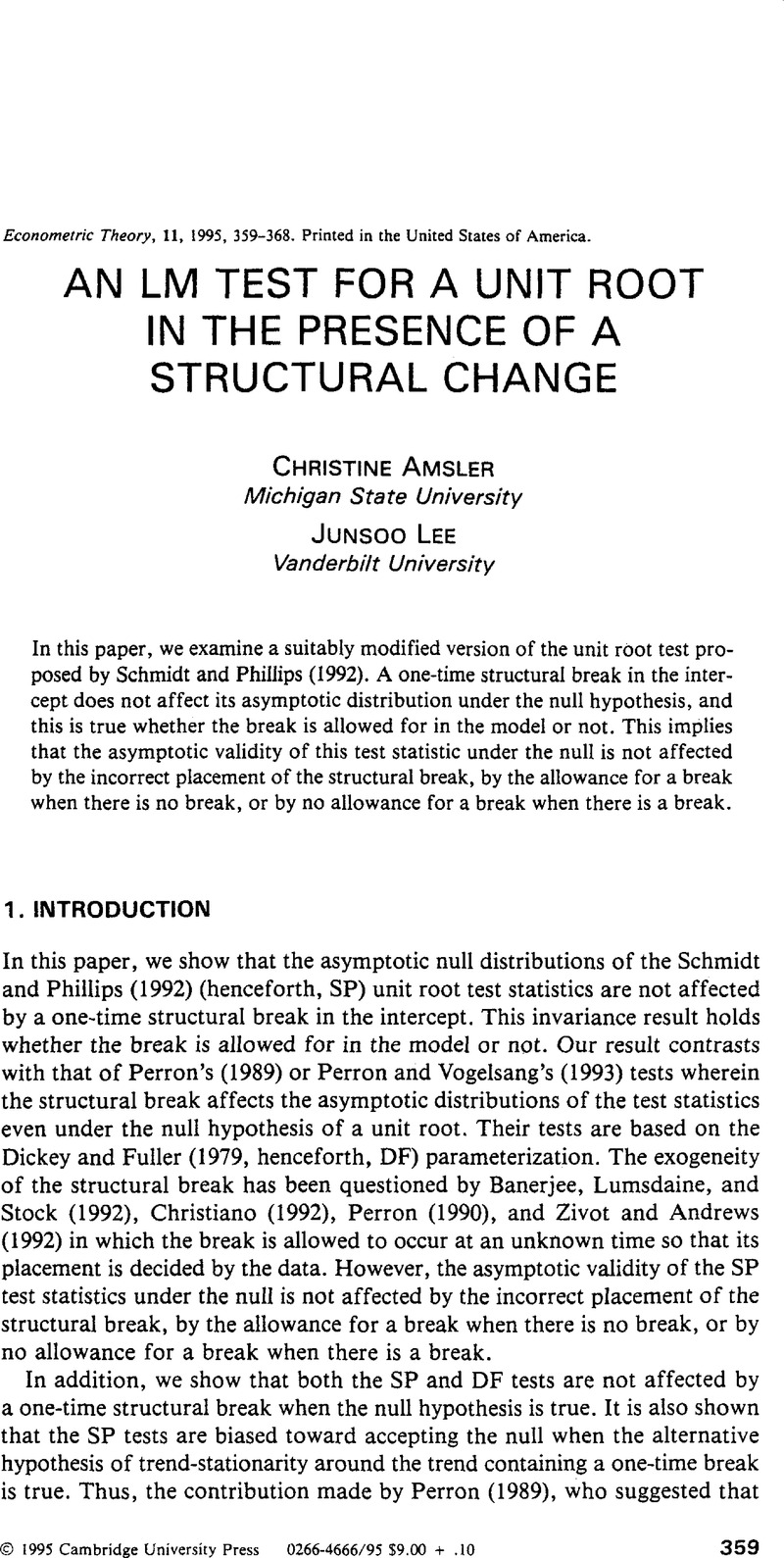Crossref Citations
This article has been cited by the following publications. This list is generated based on data provided by Crossref.
Lee, Junsoo
Huang, Cliff J.
and
Shin, Yongcheol
1997.
On stationary tests in the presence of structural breaks.
Economics Letters,
Vol. 55,
Issue. 2,
p.
165.
Breitung, Jörg
and
Gouriéroux, Christian
1997.
Rank tests for unit roots.
Journal of Econometrics,
Vol. 81,
Issue. 1,
p.
7.
Lee, Junsoo
and
Amsler, Christine
1997.
A joint test for a unit root and common factor restrictions in the presence of a structural break.
Structural Change and Economic Dynamics,
Vol. 8,
Issue. 2,
p.
221.
Lee, Junsoo
1999.
Nonlinear Time Series Analysis of Economic and Financial Data.
Vol. 1,
Issue. ,
p.
143.
Saikkonen, Pentti
and
Lütkepohl, Helmut
2000.
Testing for the Cointegrating Rank of a VAR Process With Structural Shifts.
Journal of Business & Economic Statistics,
Vol. 18,
Issue. 4,
p.
451.
Shin, Dong Wan
and
Oh, Man-Suk
2000.
Semiparametric tests for seasonal unit roots based on a semiparametric feasible GLSE.
Statistics & Probability Letters,
Vol. 50,
Issue. 3,
p.
207.
Lee, Junsoo
2000.
On the end-point issue in unit root tests in the presence of a structural break.
Economics Letters,
Vol. 68,
Issue. 1,
p.
7.
Lanne, Markku
Lütkepohl, Helmut
and
Saikkonen, Pentti
2002.
Contributions to Modern Econometrics.
Vol. 4,
Issue. ,
p.
151.
LANNE, MARKKU
LÜTKEPOHL, HELMUT
and
SAIKKONEN, PENTTI
2002.
Comparison of unit root tests for time series with level shifts.
Journal of Time Series Analysis,
Vol. 23,
Issue. 6,
p.
667.
Lanne, Markku
and
Lütkepohl, Helmut
2002.
Unit root tests for time series with level shifts: a comparison of different proposals.
Economics Letters,
Vol. 75,
Issue. 1,
p.
109.
Lanne, Markku
Lütkepohl, Helmut
and
Saikkonen, Pentti
2003.
Test Procedures for Unit Roots in Time Series with Level Shifts at Unknown Time*.
Oxford Bulletin of Economics and Statistics,
Vol. 65,
Issue. 1,
p.
91.
Lee, Junsoo
and
Strazicich, Mark C.
2003.
Minimum Lagrange Multiplier Unit Root Test with Two Structural Breaks.
Review of Economics and Statistics,
Vol. 85,
Issue. 4,
p.
1082.
Jewell, Todd
Lee, Junsoo
Tieslau, Margie
and
Strazicich, Mark C.
2003.
Stationarity of health expenditures and GDP: evidence from panel unit root tests with heterogeneous structural breaks.
Journal of Health Economics,
Vol. 22,
Issue. 2,
p.
313.
Harris, Richard D. F.
and
Tzavalis, Elias
2004.
Testing for Unit Roots in Dynamic Panels in the Presence of a Deterministic Trend: Re-examining the Unit Root Hypothesis for Real Stock Prices and Dividends.
Econometric Reviews,
Vol. 23,
Issue. 2,
p.
149.
Lütkepohl, Helmut
2004.
New Directions in Macromodelling.
Vol. 269,
Issue. ,
p.
107.
Hassler, Uwe
and
Rodrigues, Paulo M. M.
2004.
Seasonal Unit Root Tests Under Structural Breaks*.
Journal of Time Series Analysis,
Vol. 25,
Issue. 1,
p.
33.
Im, Kyung‐So
Lee, Junsoo
and
Tieslau, Margie
2005.
Panel LM Unit‐root Tests with Level Shifts*.
Oxford Bulletin of Economics and Statistics,
Vol. 67,
Issue. 3,
p.
393.
Darné, Olivier
and
Diebolt, Claude
2005.
New Trends in Macroeconomics.
p.
173.
Lluís Carrion‐i‐Silvestre, Josep
Del Barrio‐Castro, Tomás
and
López‐Bazo, Enrique
2005.
Breaking the panels: An application to the GDP per capita.
The Econometrics Journal,
Vol. 8,
Issue. 2,
p.
159.
Hurlin, Christophe
and
Mignon, Valérie
2005.
Une synthèse des tests de racine unitaire sur données de panel.
Économie & prévision,
Vol. n° 169-170-171,
Issue. 3,
p.
253.



